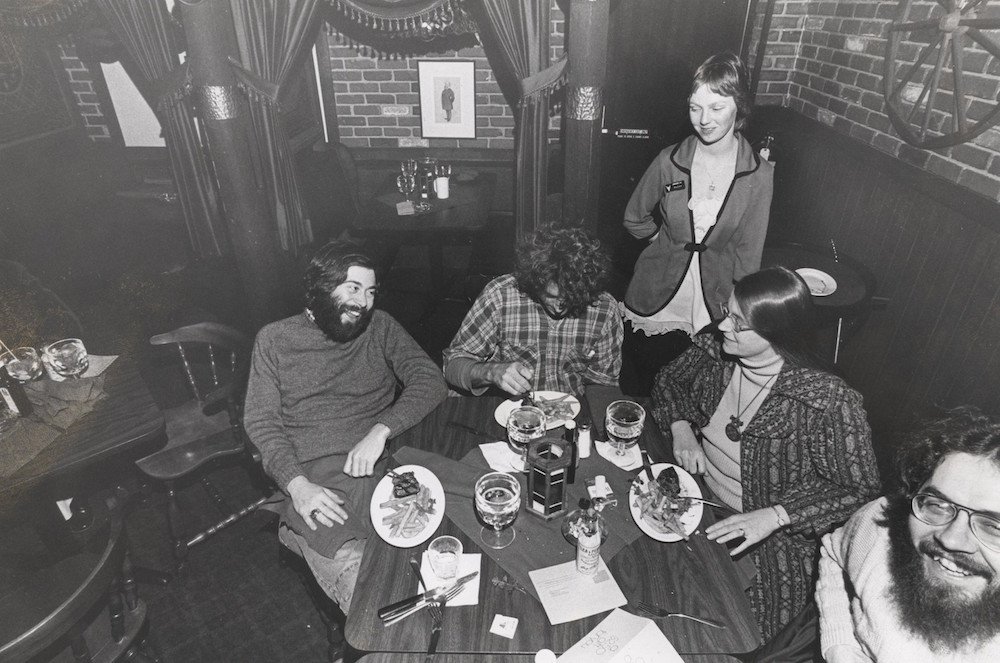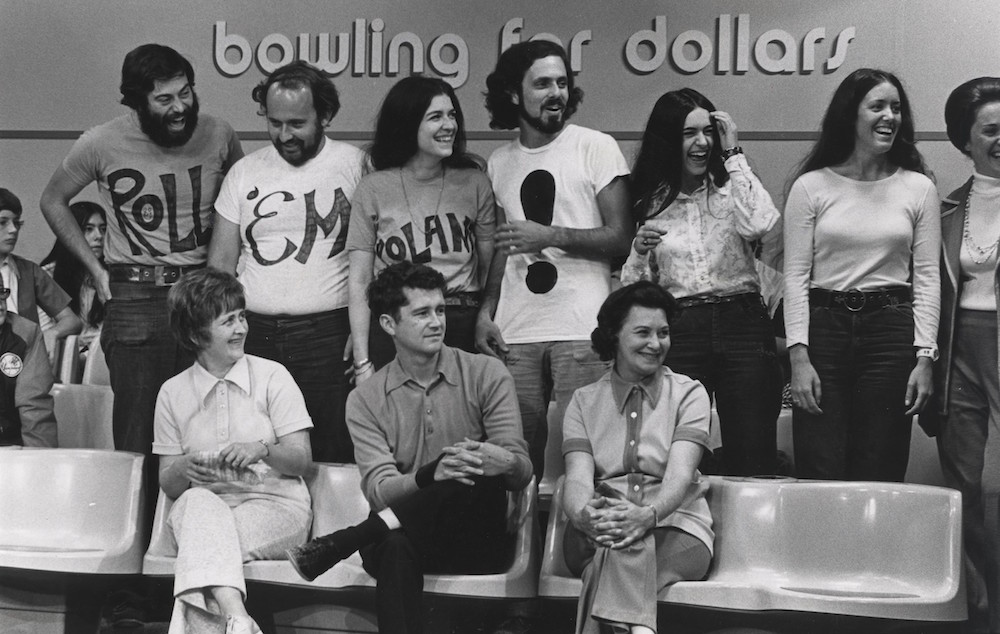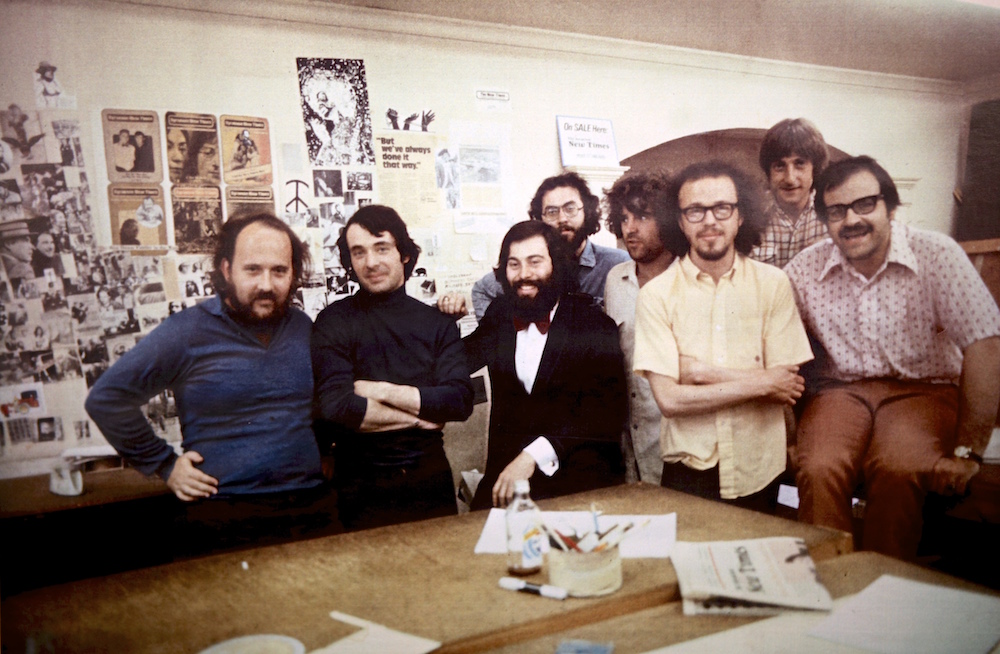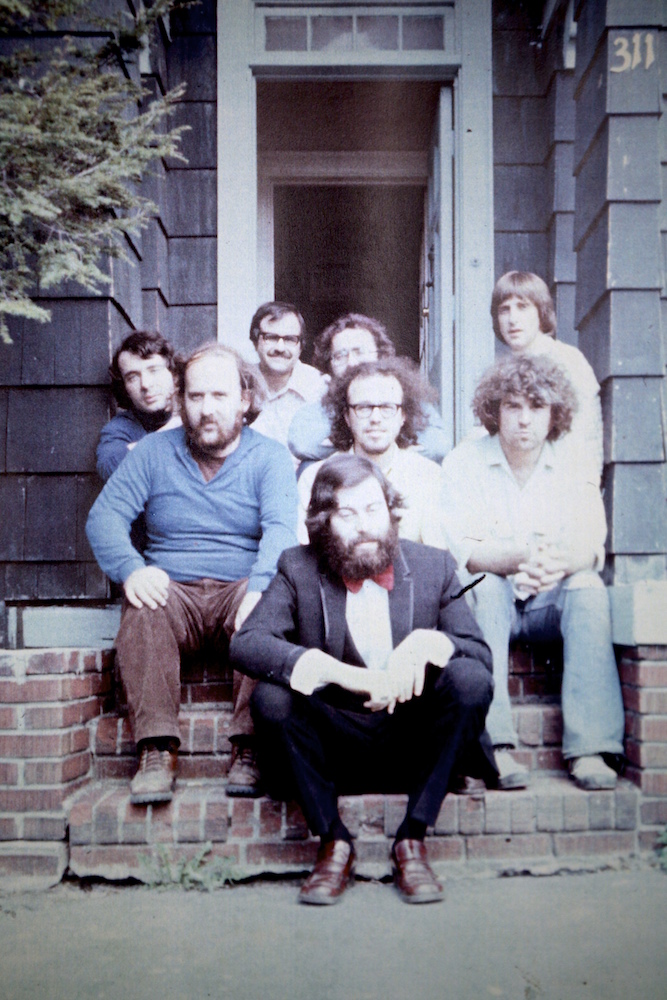The Syracuse New Times could not let 2015 slip away without saluting the memory of Roland Saunders Sweet, who passed away July 24 from heart failure at age 69.
Sweet is best known to faithful readers of News and Blues, his weekly column featuring wacky news items from around the globe. His byline attached to that column has remained a constant presence in this alternative newsweekly for more than 40 years, a record likely to go unchallenged — unless the NCAA steps in and vacates a number of previous issues.
The tributes came quickly. “This is so sad,” said Ken Simon, the paper’s founder and publisher from 1969 to 1980. “I loved Roland’s point of view, his wit, his attitude and his writing.” John Kokot, a New Times editor in the mid-1970s, hailed Sweet as “a Renaissance man.” Carl Mellor, who continues to pen art reviews for this paper, recalled that Sweet’s restaurant reviews (as the Broke Gourmet) would sometimes lead to free eats from delighted venues.

Frank Malfitano, an award-winning New Times writer during the 1970s, lamented, “We’ve lost yet another wonderful friend and media colleague in a year that’s already claimed a huge number of major media professionals from the Central New York region, including Ron Bee, Joe Galuski, Andy Brigham and Bill Carey. Roland was a terrific editor, very fair, great to work with, and a fun character. Nothing tops the stunt he pulled on the old Bowling for Dollars TV show hosted by former television weatherman Bud Hedinger. It was an absolute classic!” More about that later.
Sweet’s contributions to the Syracuse New Times began in 1974 when he walked into the paper’s 311 Comstock Ave. office at age 28, with no background as a writer or journalist. “What causes someone to spend a dozen years at The New Times?” Sweet mused during an article for the paper’s 20th-anniversary issue published Feb. 15, 1989. “In my case, it was a birth defect. I was born to write for The New Times.”
Along the way, Sweet served two separate stints as editor-in-chief, from 1980 to 1981 and 1984 to 1985. Sweet initiated Walt Shepperd’s 35-year career as senior editor and the paper’s first full-time writer by pushing a desk into the editorial department on Franklin Street and telling him to sit down. The only editorial change Sweet penned on Shepperd’s copy was to add a sentence at the end of a column describing a cultural thaw in the cold war with Russia, an exchange of visits between opera and ballet: “We won.”
Early in their collaboration, Sweet sent Shepperd a note for permanent display on his bulletin board. “A column should have a beginning, a middle and an end, and make a point,” it noted, “not just run 500 words and end.”
Yet Sweet did not know at the time that his Syracuse New Times career would last for 12 years and 624 consecutive issues. “The day I joined the paper, it started going out of business,” he reflected in 1989. “Nobody who worked at the paper ever dreamed it would survive. So you write a paper that reads like every issue is the last. You give it your best shot and screw the consequences.”
With nothing to lose on a weekly basis, Sweet became a multi-hyphenate columnist for the Syracuse New Times. He penned reviews of greasy-spoon joints in his Broke Gourmet guise, supplied humorous accounts as the Minstrel Pig, drew often indecipherable cartoon panels with his Albania comic strip and scoured neighborhood newspapers and wire service copy to track down arcane items of interest for News and Blues. Along the way, and accompanied by anarchic co-conspirators such as editor-in-chief Mike Greenstein, Sweet helped shape the irreverent, pointed style of journalism that should be at the heart of any self-respecting alt-weekly.
Which leads us to the night when Sweet and members of the Minstrel Pig Traveling Fan Club (which included Greenstein, Mellor and others) invaded Channel 3’s live television broadcast of Bowling for Dollars with meteorologist-host Bud Hedinger. “Bowling for Laughs with Bud,” Sweet’s Minstrel Pig column for Sept. 15, 1974, offers a detailed account of the surreal experience, which started with Sweet feeding straight lines to an unsuspecting Hedinger during the pre-interview. The show went downhill from there:
“When Bud asked what he did at the Syracuse New Times, Pig recalled his goof line. Resplendent in his garish shirt from the Salvation Army store, he announced, ‘I’m the fashion consultant.’ Bud stared at his cue card. It made no mention of that job. He smiled nervously. When Bud asked about hobbies, Pig said he played the cello and made homemade armaments. When Bud asked Pig to say hello to some people at home, Pig said, ‘Al Roker, Steve Newman and Dave Eiser,’ who are weather reporters on other local TV stations.”
Sweet, unable to land a strike and collect a $1,140 jackpot, wound up with a $9 consolation prize. Yet 40 years later he was still making fun of Hedinger, who has since become a conservative pundit for an Orlando, Fla., radio station: “I noticed on Bowling for Dollars how the ball always rolled to the right.”

Following his 12-year New Times tenure, Sweet relocated to Virginia (accompanied by his wife Theodora Tilton, a former New Times art director), where he helped launch the special interest magazine Log Home Living in 1989. Malfitano, who was then the associate publisher of Jazz Times magazine in Silver Spring, Md., recalls that he and Roland had season tickets to Washington Bullets basketball games. They also reconnected with Harry Rado and Tom Corradino, two members of the former Salt City group Bad Medicine, who played in the Beltway-area band Little Red and the Renegades.
Among his many accomplishments, Sweet earned his private pilot’s license, was given a Lifetime Achievement Award by the Syracuse Press Club (despite some acts of misbehavior; more about that later) and won the Literacy Council of Northern Virginia’s Outstanding Tutor/Teacher Award for tutoring a Guatemalan immigrant in spoken and written English.
News and Blues will forever remain Sweet’s legacy, as angry New Times readers demonstrated with their hate mails when it was dropped for one issue last spring to accommodate a late-breaking story. “The bad news,” Sweet said with tongue in cheek, “is that reader demand will further postpone my retirement, now five years overdue.”
Nevertheless, following Sweet’s death, rationing has been the method for stretching out the News and Blues stockpile, with that well of goodies soon to run dry in early 2016. There is a precedent for this posthumous philosophy, however: When cartoonist Virgil Partch, best known for the long-running strip Big George, died in a 1984 car crash, he left behind a six-year backlog of unpublished panels. Longtime Syracuse New Times fans may recall reading about this bizarre fact in — where else? — a News and Blues column.
A quartet of Syracuse New Times regulars offered their own rose-colored memories of Roland Sweet:
James MacKillop, stage critic: Albert Einstein always claimed his own top virtue was impudence. Roland Sweet would have been reluctant to speak of his virtues, and he’d likely slap me upside the head for comparing him with Einstein, but, yes, this was a man who thrived on impudence. He looked at the problems of social disorder and crime and came up with the News and Blues phrase, “Mensa Reject of the Week,” a lasting contribution to the dictionary of Americanisms.
Regular readers of News and Blues detect and undercurrent of political commentary, but they’re not sure which way it points. His intellectual and journalistic hero was H.L. Mencken, the scourge of middle-class complacency who gave us the coinages “booboisie,” “great unwashed” and “Bible Belt.” Like Mencken, Roland was sometimes mistaken for a rightist because he tweaked liberal pieties. The truth was he never saw a piety he did not wish to tweak.
Whenever of the question of my Scottish heritage came up, Roland would be quick to remind me that haggis was the world’s most detestable edible. He didn’t need me as a foil, however; he also said it in print. But the truly impudent man is never pinned down by a cliché. When he finally got to Scotland he sent me an email to say he had some haggis and was crazy about it.
Impudence prompted his life-long championing of Albania, an anti-utopia whose leaders oppressed their subjects with glee, and whose residents treated each other like Balkan Hatfields and McCoys. This does not mean Roland sneered in any way. His email address included the name Hoxha, after Enver Hoxha, the brutal Communist dictator who brought the country even closer to dystopia.
One of the greatest favors I ever did him was to drive two hours across Southern California to Hermosa Beach, venue of one of America’s few Albanian restaurants. I bought a copy of the large menu, emblazoned with a huge black eagle. More recently, Albania has opened up as a tourist destination. I suggested we go together, without our wives. But the new Albania has bedbug-free mattresses and toilets that flush, not the country he had always dreamed of.

None of this should suggest that Roland only wanted to badger you and, at rest, could just be good and amusing company. He was flattering to my quixotic quest to walk on every street in Syracuse. In the early years, the Syracuse New Times paid him so little that he did not own a car and so walked everywhere. This was, he said, the foundation of his love for Syracuse. Once he acquired a car and started driving, it did not feel like quite the same city.
In the earlier, wilder years, I knew Roland only from print, when I was a stringer doing perhaps two or three items a year. I wasn’t there for the grand impudence, like stories about Syracuse’s lost subways. Further, I’d be dishonest if I implied we were great and close pals. He was older and more restrained when he was my editor and I began to write for every issue in the mid-1980s. We spent a long evening over Chinese sour soup to define how a weekly was different from a daily and how the Syracuse New Times could offer something worth picking up if a movie or show had already been covered in the then-two Syracuse broadsheets.
It was quite a seminar. We started with the difference between the daily London Times and the separate Sunday Times (both since ruined by Rupert Murdoch). Then the New York Times beside the Village Voice. Then The New Yorker, Time and Newsweek. What we hammered out is that a New Times review would be an essay in context. Never just “Loved her/hated him” but a placement of the show within a discussion of comedy, tragedy or melodrama or the careers of the writer, director or performers. The review would not be a report card on the performers. Time and Newsweek (what’s left of it) don’t do this anymore. The Syracuse New Times tries to.
Tom Peyer, occasional cartoonist: In the 1980s, Roland and I joined the Syracuse Press Club, because we’d heard, correctly, that their meetings featured free beer. Roland became a serious participant — “serious” for him — going on to edit the club newsletter. But this in no way diminished his commitment to our original shared purpose, which was to drink club beer.
One year, we went to their annual dinner. This being the 1980s, the club paid for an open bar. I want to say two hours of free drinking before we sat down to eat with all the reporters, politicians and public relations people. Roland and I were really hammered, and it felt like we were the only ones.
We hadn’t anticipated all the rituals that made up an “annual dinner.” Which was stupid. Because the first thing we were told to do was stand for the Pledge of Allegiance. And a prayer.
We started laughing helplessly, and trying to look like we weren’t, like kids in church. We were seated near the front, so everyone in attendance could see our shoulders quaking. Stifling that laugh was physically painful. The pledge and the prayer lasted approximately 100 years, and every time we glanced at each other out of the corner of our eyes, we laughed harder and it hurt more.
Some of the Press Clubbers were good sports about it. The ones who weren’t shot us some dirty looks but otherwise steered clear. And the rituals wore on, speaker after speaker, piety after piety. The laughter started to rise again, and Roland and I raced out of there long before the dinner ended.
So that’s my favorite memory. The day Roland and I, both in our 30s, got to be kids together. Bad, drunk kids.
Michael Davis, photographer: I was 30 years old and had been doing public relations at Salt City Playhouse a month earlier, until I left with the intentions of getting work as a photographer. And, of course, the paper I wanted to work for was the Syracuse New Times, because of all the music, arts and entertainment and theater coverage.
One day in May 1981, I got a call from an adult bookstore to photograph a meet-and-greet with adult film star Annie Sprinkle, with some of her fans. I really didn’t want to do the job because I thought it would hurt me later if other employers saw me as “the guy who photographs at adult bookstores.” But my mother said, “If you’re going to be a photographer you’re going to have to photograph all kinds of things.” Mom always said, “If a door opens, you should walk through it,” so I did.
It was a Saturday morning and I was doing the pictures of Annie meeting fans, and a guy came over to me and introduced himself. It was Roland Sweet. At that time Roland was the editor of the Syracuse New Times and was at the adult bookstore not as a fan but as a reporter doing a story on, as he described it, “new wave porn.” It turns out that Annie Sprinkle was more than an adult film star but someone who had taken control of her image and publishing and filmmaking, and saw pornography as an art form. I think there was also a strong women’s lib thing in there. She was very intelligent and an accomplished photographer who had been taught by some of my photographer idols—all of which I found out later.
Roland knew about some of this and thought she would make a good story for the New Times. He explained to me that the regular photographer didn’t show up; they were using a guy who also shot wedding photos and a wedding had come up. This was a very visual story and they now needed a photographer and he asked me if I had any experience and he asked if I might be able to take any photographs that the Syracuse New Times might be able to use.
At this point I introduced myself and I could see that Roland was relieved: He knew my pictures from my having submitted stage photos when I was doing PR at Salt City. He invited me to stick around for the rest of the assignment, which included lunch with Annie Sprinkle and an interview that afternoon. He made me feel like I was on staff even though I wasn’t.
At the end of the day, he said, “Bring some photographs down on Monday and we’ll see if there’s anything that’s usable.” I showed up with a manila envelope containing about 15 prints, and Roland looked at them and said, “We’ve got this week’s cover story!” Based on the photographs it went from being a small feature to a cover story.
This was the way Roland seemed to work. Although he ran a pretty tight ship and liked to know what was in the paper week to week, if the opportunity came up he was open to things just happening. He was totally willing to put it on the cover because it was just a good story: He had a good subject, he had good art and so he made it a cover story. That Wednesday when the paper came out, I stopped down to the Syracuse New Times to pick up a few copies.
We still hadn’t discussed a price for the pictures or anything and Roland surprised me by saying “I’d like you to be the inquiring photographer” and put me on at $25 a week. The Inquiring Photographer was a weekly column: Roland would come up with a question and I’d go out and photograph between four and six people who were willing to be photographed and answer a question, such as “What do you think of Lee Alexander’s cat?” (That was a running gag in Tom Peyer’s Sideshow comic strip at the New Times at the time.) It was usually a question on a local issue.
Within a couple of weeks Roland offered me a job as the New Times photographer and started to give me regular assignments. Roland started my career as a photojournalist. It might have been out of convenience — that he just needed someone or that he actually saw something in my work. Within minutes of that first meeting, I was part of the team. It was easy. He was a good editor to have. He was always open. He was willing to take chances, he wasn’t afraid to ruffle feathers, and he always inspired good work from his staff. You wanted to do good for him; you always tried to do the best. You were all in it together. No matter what was going on, it was a happy ship. And at time, the paper went through some rough waters.

He sent clippings from magazines that had crossword puzzles on the back, always filled in completely with no erasures. Even his handwriting was pristine. He scribbled beautifully lettered, readable words in tiny notebooks that he pulled out of his pockets and satchels.
A dedicated baseball fan, he planned every trip to the ballpark in minute detail, from his route to where he would park his car to what he would eat during the game. He kept score diligently, and taught countless others to do the same.
Yet when I met him in the early 1970s, Roland was a disheveled, curly haired wanderer, living in Syracuse for no apparent reason, working as a hospital orderly and living in the city’s most dilapidated housing project, sleeping on a mattress on the floor amid piles of books and dirty laundry.
He contacted me, then the editor of the Syracuse New Times, to answer an ad for writers. Unlike most who responded, he could write. His humor column, The Minstrel Pig, was born, and it blossomed into an ever-expanding role at the paper, culminating as editor-in-chief. From there he went on to a decorated career in trade magazine journalism while syndicating the column that began in the Syracuse New Times as News and Blues and continues to this day (in a dozen other North American papers, it is called Newsquirks).
The seeming contradiction between scruffy humorist and obsessive editor was typical of Roland, whose favorite novel was not coincidentally Joseph Heller’s Catch-22. Roland worked hard at being contrarian. In one infamous New Times restaurant review, he demeaned its elderly clientele as “cardboard cutouts.” Later on, he worked at Seniority magazine. He joined the Syracuse Press Club as a lark, because the meetings featured paltry attendance and therefore lots of free beer and snacks for those who went, but he wound up with its Lifetime Achievement Award.
As a writer and editor, his use of language to communicate was precise, yet he also created the comic strip Albania, which derived its humor from its absurdity and lack of communication. Roland made plenty of fun of foreigners in his writing, not only Albanians but French and Canadians and others as well, but he volunteered to teach English as a second language and won accolades for doing so.
While his thriftiness was legendary (he was, after all, the Broke Gourmet), as an amateur aviator he would rent a small plane for hundreds of dollars so he could fly it to Skaneateles to get his favorite hot dog at Doug’s. Curmudgeonly Roland could be gruff and grumpy, all right, but at heart he was deeply kind, understanding and intensely loyal to his closest family, his legions of friends, his cherished pets and sometimes even to the strangers with whom he often struck up conversations at a baseball game, a trade show, a restaurant or a food stand.
Roland was expert at many things, and he authored books on weird news, log homes and other topics in addition to Albania. His next endeavor, he often promised, would put forth another contrarian theme: No new product or invention is ever as good, as efficient or as reasonably priced as what it replaced. His working title was Nothing New Is Ever Better. But as the editor with the final word on the topic, I will amend that title: Nothing New Will Ever Be Sweeter.



